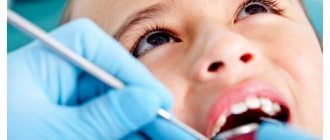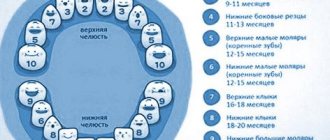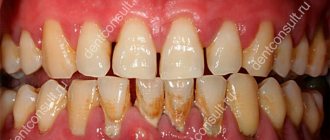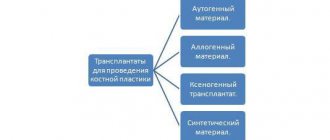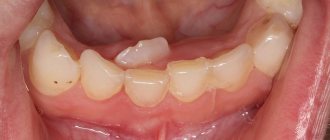The appearance of our front teeth plays a very important role in how others perceive our appearance. They are not only the first thing that catches your eye when you smile, but they are also more likely to be injured than others. You hear a lot from patients who have had a piece of their tooth chipped : “I couldn’t dodge a blow during training,” “I had nothing to open a bottle of beer with,” “I chewed on a caramel.” Enamel, which is the hardest tissue in the body, does not always withstand falls from a horse and hits from a tennis ball. As a result, chips of various sizes are formed on the cutting edge of the tooth. What can modern dentistry offer in this case?
When do baby teeth start falling out?
During the first three years of life, a child grows 20 baby teeth. At this time, a temporary bite is formed: it is distinguished by a pronounced anatomical shape, thin enamel, and susceptibility to caries. After the first three years, the roots of baby teeth slowly dissolve, making room for a permanent bite. From the age of 4-5 years, baby teeth begin to fall out, and this continues until the fifth or sixth grade of school.
In most cases, the process occurs calmly and does not require third-party intervention, including medical attention. Dentists strongly advise against rushing things.
Possible reasons why a child’s baby tooth has fallen out
The main reason for the loss of baby teeth is the eruption of permanent teeth. The process of replacing baby teeth is preceded by the resorption of their roots. After root loss, the baby tooth becomes loose and falls out. Most often, the process does not cause the child significant discomfort or pain, and the vacated space is subsequently filled with the erupting permanent incisor.
Replacing a baby tooth with a permanent one
Attention! The replacement of baby teeth with permanent ones is a natural process established by nature. Root teeth are stronger and more resilient, they are distinguished by the hardness and density of the enamel, therefore making it easier for the child to adapt to adult food.
The first loss of baby teeth occurs after the child reaches the age of six, which is considered the norm in dentistry. It takes 6 to 8 years for permanent teeth to form.
Why shouldn't you remove baby teeth yourself?
Removal of a baby tooth is considered premature if more than a year remains before a new one appears. This period is difficult to predict accurately, but you can roughly estimate it using a graph with average indicators.
Premature removal of a baby tooth is dangerous because its neighbors will try to take the vacant space. The roots of permanent teeth that are about to emerge will become crowded. The bite will change, which will take a long time to correct. Moreover, there are several strict contraindications for extracting baby teeth:
- Acute inflammatory diseases of the oral cavity.
- Inflammatory diseases of the throat (ARVI, sore throat, etc.).
- It is not recommended to remove teeth for pathologies of the cardiovascular system, kidneys, central nervous system, blood diseases, vitamin deficiency and nutritional dystrophy.
So when your child's first baby teeth start to loosen, don't disturb them and let them fall out naturally. The child's body knows its business.
When a tooth is already loose, it needs to be cleaned very carefully so as not to rush things. If your child is still in kindergarten and his motor skills are not well developed, help him: take ASEPTA® Baby dental wet wipes and wipe the tooth (as well as its neighbors) from the top and sides.
Is there a fever when changing baby teeth to permanent ones?
As noted above, the process of replacing baby teeth begins at about 5 years of age. If this happens in children during the specified period, then in this case there is nothing terrible, that is, there is no reason for concern: such a condition should be considered completely natural. The loss of baby teeth does not cause pain to children, since the roots dissolve first, and only after that one of the elements can be seen swinging.
What to do if a baby tooth falls out?
For the first 2-3 hours after the removal of a baby tooth, eating should be excluded, so before visiting the dental office or starting the procedure at home, you should feed the child. You also need to take care of how to treat the wound if your child has lost a tooth.
To rinse the mouth, you can use both ready-made solutions (for example, Rotokan) and home-made analogues.
An excellent disinfectant folk remedy is a decoction based on chamomile or sage, but it is recommended to use them only when chilled, because hot liquid interferes with the normal healing of the wound. This warning also applies to eating hot food.
After rinsing, you can apply a piece of cotton wool soaked in the same solution to the hole and leave for 15-20 minutes.
After the specified time, the tampon must be removed, after which it is recommended to provide absolute rest to the wound. For the next three days, it is better to do without rinsing the mouth and spitting, because it is extremely important to keep the formed blood clot in the wound. Eating food is allowed if more than 2 hours have passed since the loss of a baby tooth , as evidenced by the absence of discharge from the socket. Otherwise, it’s better to hold off on breakfast.
Do you need pain relief?
Anesthesia when removing temporary units is necessary when they are pulled out before the roots are reabsorbed. Without anesthesia, the procedure will cause pain to the child, since there are many nerve endings in the oral cavity. When removing, the following anesthesia methods are used:
- General anesthesia. They are used only if the child has mental illness or other remedies do not work on him.
- Local anesthesia with spray or gel. The method is suitable if the unit begins to wobble and does not cause severe discomfort.
- Anesthetic injection. The injection is given in the gum. Anesthesia lasts longer than when using gels and sprays, and has a more pronounced analgesic effect.
After the process is pulled out, a small bleeding wound is formed. To speed up the healing process and eliminate the risk of infection, you must do the following:
What to do if blood appears during tooth loss?
Some parents immediately panic when their baby starts bleeding during the loss of a baby tooth, but this should not be done. This process is considered absolutely normal; it occurs due to the fact that there are a large number of blood vessels in the oral cavity. When a tooth falls out, these vessels burst, and therefore a bleeding process occurs. To stop the bleeding, the following measures should be taken:
- If blood appears, the child should be given a cotton swab or piece of gauze. He must press it to the hole with blood and hold it for a while. Usually the bleeding stops quickly;
- It is not recommended to use hydrogen peroxide to rinse the mouth, because it will only irritate the wound, but will not bring a positive result;
- If the bleeding does not stop and simple manipulations do not help stop it, then you should go to see a dentist;
- In the first period after tooth loss, the child should rinse the mouth with a solution with a weak salt concentration.
Sometimes there are situations when a tooth falls out unnoticed even by the child himself, and he may accidentally swallow it. In these cases, it is worth contacting a dental specialist who will examine the hole and be able to determine whether the tooth has completely fallen out or whether part of it has broken off. If it turns out that the tooth has fallen out and the child has no complaints, then soon enough it will leave the body naturally.
Rinsing with a weak saline solution will disinfect the oral cavity and inflammation after the loss of a baby tooth.
Sometimes there are situations when a tooth falls out unnoticed even by the child himself, and he may accidentally swallow it. In these cases, it is worth contacting a dental specialist who will examine the hole and be able to determine whether the tooth has completely fallen out or whether part of it has broken off. If it turns out that the tooth has fallen out and the child has no complaints, then soon enough it will leave the body naturally.
What to do with your child's lost baby teeth
Nowadays it is increasingly practiced to come up with a whole story, fairy tale or ritual after the loss of a baby tooth. They say that the worst and most unnecessary tooth falls out first. It is believed that it must be buried deep into the hole. It is this procedure that will allow the remaining teeth to be much stronger and healthier.
So what to do with the tooth:
- Throw it away. If your family has never followed the ritual of losing baby teeth and your little one has never heard of, for example, the tooth fairy, then you can simply get rid of the tooth. However, I would still recommend at least burying it and wishing that the baby grows strong teeth.
- Tooth Fairy. We learned about the existence of this fairy-tale hero from foreign films. Today, the tooth fairy has already become widely known among children in our country. Therefore, you can use such a legend. Let the baby put the lost tooth under his pillow, and while he is sleeping, the fairy will come, take the tooth and leave something in return.
- Mouse. I heard about this character back in my childhood. Grandma said that a lost tooth should be hidden in a secret place, preferably dark, for example, under a closet. In addition, you can throw a tooth over your shoulder, saying a request for the mouse to have strong teeth.
- Keep the tooth as a keepsake. For example, I did just that. Some parents like to keep mementos, such as a cast of their one-year-old child's foot or the first hair they cut. It is not surprising that the first milk tooth also has a place here.
- Amulet. Some families believe that baby teeth have magical powers. In this case, parents may decide to put the tooth in a secret place and hope that now there will be only prosperity and happiness in their family. The main thing is to believe in the power of this talisman.
- Decoration. In my opinion, this is the craziest option for what you can do with a lost tooth. But there are also such cases. Mom can take the lost tooth to the workshop and ask that it be framed with precious metal. And then wear it as decoration.
Indications for milk tooth extraction
However, there are several cases when teeth definitely need to be helped to fall out. For example:
- Bottle caries or other caries has damaged more than half of the tooth.
- The tooth has been loose for a long time, but cannot fall out. This makes it uncomfortable for the baby to chew.
- The tooth is broken, the sharp edge scratches the cheek or tongue.
- The root is affected by caries (there is a danger that it will damage the permanent tooth underneath).
- Pulpitis.
- There is inflammation or a cyst on the mucous membrane next to the tooth.
Do not make the decision to remove it yourself: if you see the symptoms listed above, contact your pediatric dentist. He will tell you what treatment is required.
Trying to remove baby teeth yourself at home is dangerous: their thin walls and long roots go too deep into the gums. If you pull out a tooth with a thread or other improvised methods, you can easily disrupt the growth of permanent teeth that are hidden under the milk teeth.
Don't panic! A child’s baby tooth falls out, but the root remains - what to do?
All parents sooner or later enter an unpleasant period associated with the beginning of the replacement of their child’s baby teeth with permanent ones. Such changes bring a lot of worry to moms and dads, because most often tooth loss occurs at home and there is always concern that root particles may remain in the socket.
To avoid undesirable consequences, parents are advised to familiarize themselves with all the necessary information long before the first baby tooth falls out.
What to do after removing a baby tooth?
The dentist will provide detailed recommendations based on your child’s jaw development. Below are general tips that will help your gums recover as quickly as possible.
- After a baby tooth is removed, a blood clot appears in its socket, which helps the gum heal faster and protects it from dirt. Therefore, rinsing your mouth is not recommended. The clot may become dislodged.
- The tampon that the doctor left in your mouth should be carefully spat out after 20 minutes.
- Ask your child not to bite his cheek in the area of anesthesia. When it “comes off”, painful sensations may appear.
- For a couple of days it is better to abstain from hot foods and fermented milk products, which create an environment beneficial for bacteria.
- During the first week, you should avoid heavy physical activity (especially swimming and running).
- Do not go to the bathhouse or sauna for a week.
- On the first day, it is better to eat soft, cold food.
- Help your child brush his teeth. Use only a soft brush.
Is it possible to pull out a baby tooth yourself?
You can pull out a tooth yourself only if it barely stays in the socket. Examine the child's jaw for swelling and bleeding. If you have such signs, it is better to visit a dentist. Also, you should not pull out a baby tooth yourself if your child has a cold.
Self-removal occurs as follows. Take a clean cloth and soak it in an alcohol solution. Grab the tooth with it and gently pull it out of the socket until it comes out completely. Rinse your child's mouth. Place clean, treated cotton wool in the hole for 15–20 minutes. Let the child press it well with his teeth. Do not consume food or drinks for 2 hours.
How to go to the dentist, remove a baby tooth and not scare your baby?
It is recommended that a child’s baby teeth be removed by pediatric dentists: it will be painless, safe and timely. For everything to go smoothly, a visit to the dentist should be associated with something pleasant and calm. Modern dentistry has a friendly atmosphere, new painkillers have appeared, and instruments (especially in children's offices) do not inspire fear.
Finally, our advice: don’t worry and don’t let your child worry. The calmer you are about going to the dentist, the calmer your baby will behave. Stay nearby in the dentist's office, because parental support is extremely important to him.
I would like to consult with you on what we should do with our teeth. My second daughter is 2 years old, her top two front teeth are terribly falling apart. It started with darkening, we went to the dentist, they said it was caries, but there was no point in doing anything. So they stretched it out, the teeth began to break off in pieces, one of them is now wobbly, I’m in despair, I don’t know what to do. If it falls out, what will happen? The rest will begin to move and most likely the permanent ones will also grow crooked and just as problematic. Now I notice that the top ones, which are nearby, also begin to turn yellow and darken, and become covered with a coating. They did fluoridation, but now I think we can’t do without silvering, we’ll have to go to the regional center, but we should have done it earlier. Are there any other methods to prevent the destruction of children's teeth? And what happens if the tooth does fall out, or if it stays wobbly? Someone says that it can fall out and another one will grow. I don’t know what to do anymore, I’m in a panic. Help me please. With gratitude Nelly. Tobolsk, Tyumen region.
EXPERT'S ANSWER
Hello Nellie! In order to determine why you have such a situation with your teeth, you need, of course, additional information, test results and a direct examination of the child’s oral cavity. Sometimes this is not enough to determine the cause. This is due to our environment, food, water and, of course, genetics, etc. Of course, one cannot leave the situation without control and without appropriate actions. Your daughter is still small and her baby teeth will not be coming out any time soon, so it is very important to save space for the future permanent tooth. If a tooth is removed for some reason, then this is the task of the orthodontist; replacement plates are prescribed. But, from experience, children under 3.5-4 years old do not wear them well. Therefore, it is necessary to try to preserve baby teeth until they are replaced. Deep fluoridation methods are used. We have been using this method for quite some time and the results are very good. But regularity is important here - teeth need to be coated once every 3 or 6 months, according to indications. If this is a one-time procedure or you do it less often than the doctor prescribed for you, then you will not achieve the result. Silver plating is also indicated; your doctor should give you recommendations. In addition, multivitamin preparations and calcium supplements may be prescribed. But this is also according to the doctor’s testimony after getting acquainted specifically with your situation. And, of course, oral hygiene. You should help brush your child's teeth and do so regularly. And as for sweets and sweet juices, I think you yourself know all about it.


